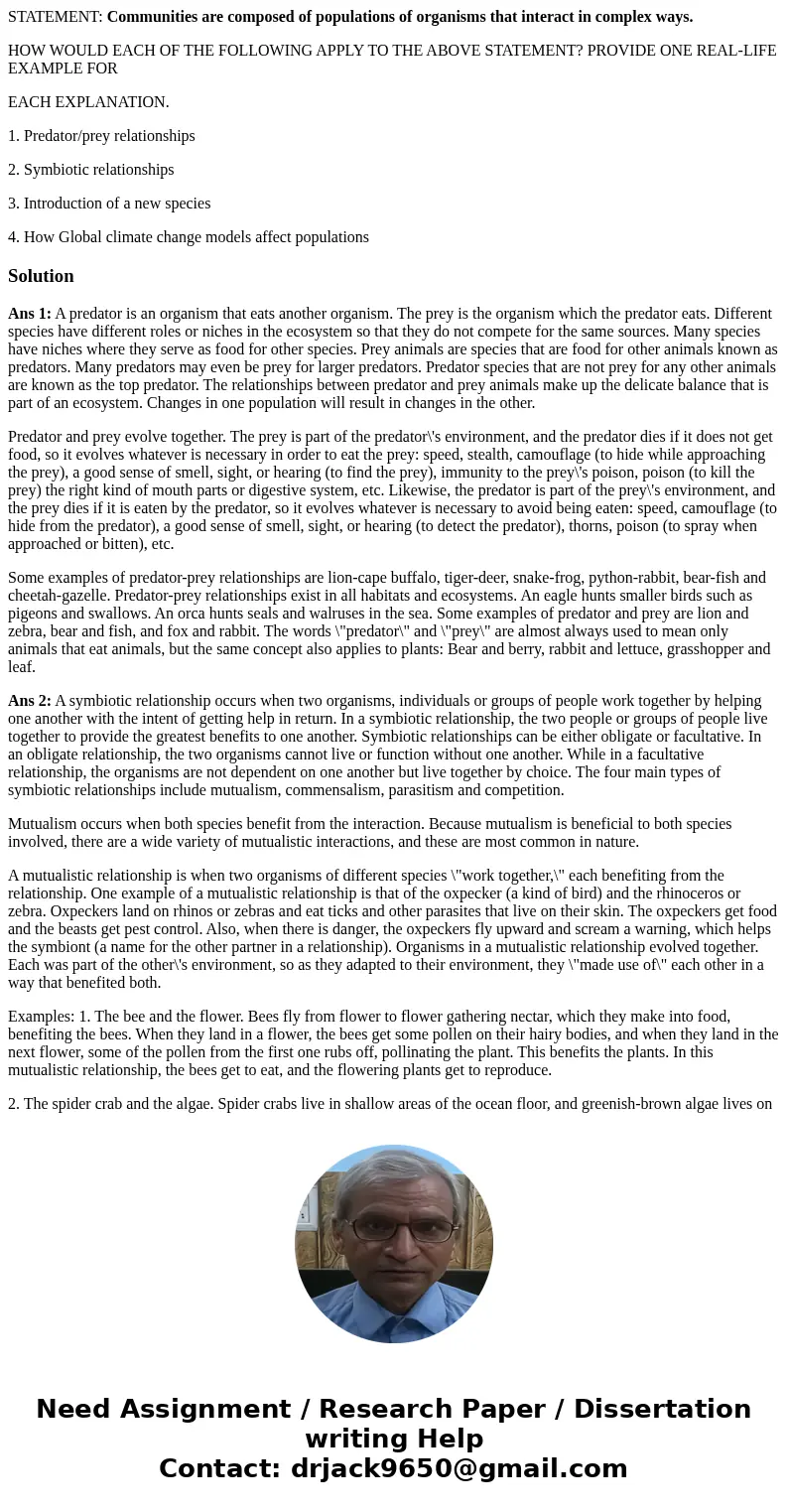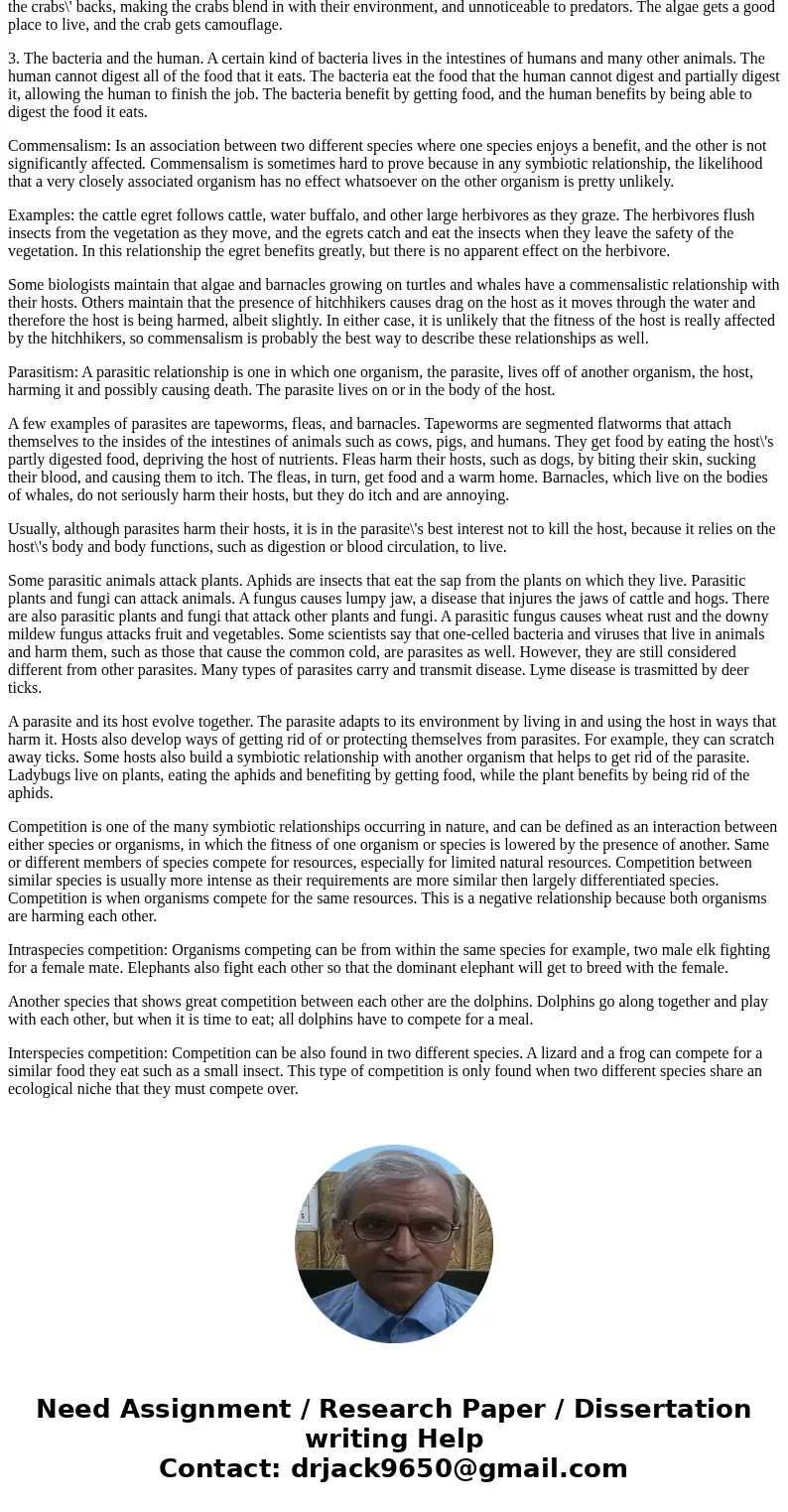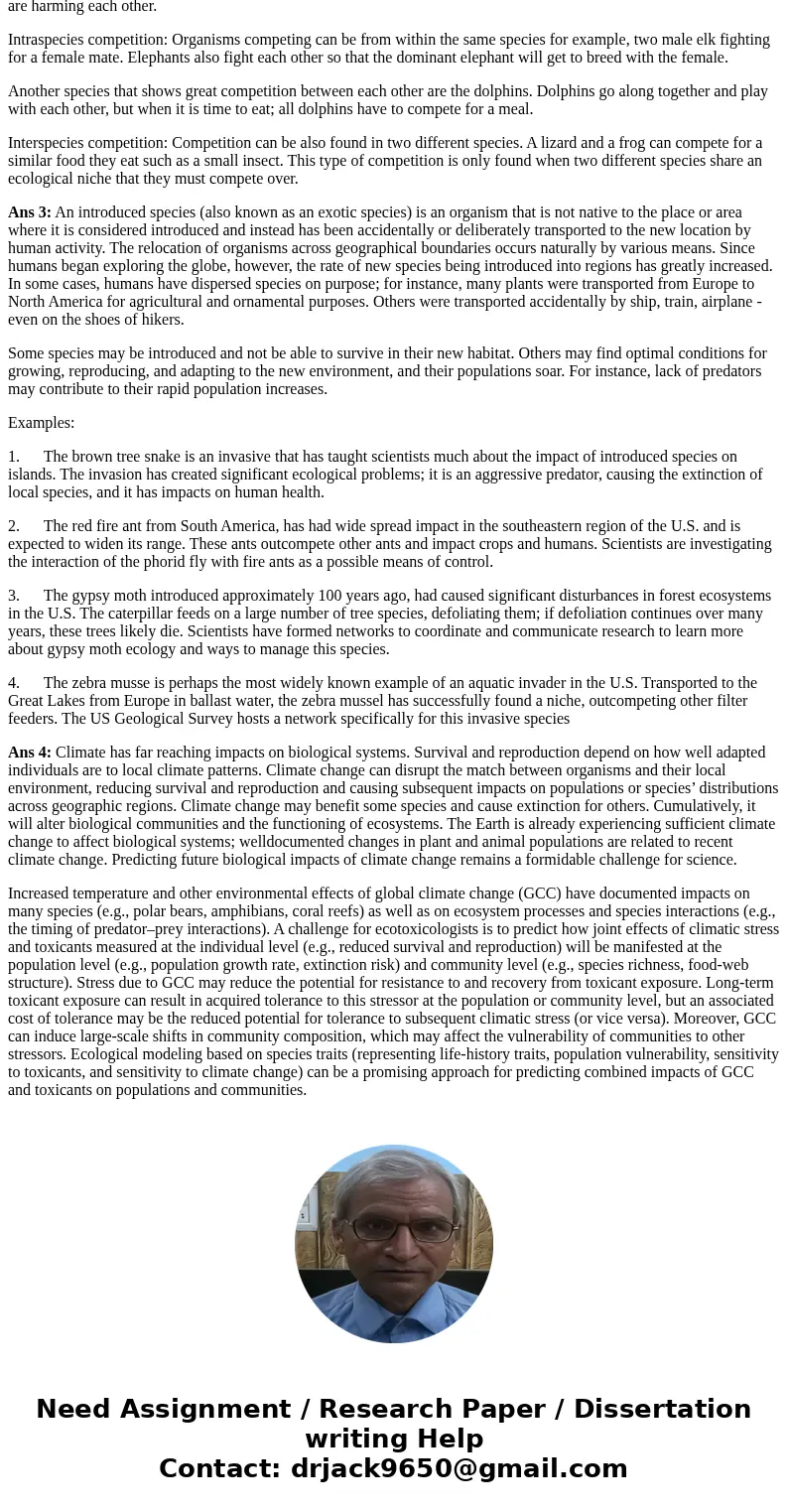STATEMENT Communities are composed of populations of organis
STATEMENT: Communities are composed of populations of organisms that interact in complex ways.
HOW WOULD EACH OF THE FOLLOWING APPLY TO THE ABOVE STATEMENT? PROVIDE ONE REAL-LIFE EXAMPLE FOR
EACH EXPLANATION.
1. Predator/prey relationships
2. Symbiotic relationships
3. Introduction of a new species
4. How Global climate change models affect populations
Solution
Ans 1: A predator is an organism that eats another organism. The prey is the organism which the predator eats. Different species have different roles or niches in the ecosystem so that they do not compete for the same sources. Many species have niches where they serve as food for other species. Prey animals are species that are food for other animals known as predators. Many predators may even be prey for larger predators. Predator species that are not prey for any other animals are known as the top predator. The relationships between predator and prey animals make up the delicate balance that is part of an ecosystem. Changes in one population will result in changes in the other.
Predator and prey evolve together. The prey is part of the predator\'s environment, and the predator dies if it does not get food, so it evolves whatever is necessary in order to eat the prey: speed, stealth, camouflage (to hide while approaching the prey), a good sense of smell, sight, or hearing (to find the prey), immunity to the prey\'s poison, poison (to kill the prey) the right kind of mouth parts or digestive system, etc. Likewise, the predator is part of the prey\'s environment, and the prey dies if it is eaten by the predator, so it evolves whatever is necessary to avoid being eaten: speed, camouflage (to hide from the predator), a good sense of smell, sight, or hearing (to detect the predator), thorns, poison (to spray when approached or bitten), etc.
Some examples of predator-prey relationships are lion-cape buffalo, tiger-deer, snake-frog, python-rabbit, bear-fish and cheetah-gazelle. Predator-prey relationships exist in all habitats and ecosystems. An eagle hunts smaller birds such as pigeons and swallows. An orca hunts seals and walruses in the sea. Some examples of predator and prey are lion and zebra, bear and fish, and fox and rabbit. The words \"predator\" and \"prey\" are almost always used to mean only animals that eat animals, but the same concept also applies to plants: Bear and berry, rabbit and lettuce, grasshopper and leaf.
Ans 2: A symbiotic relationship occurs when two organisms, individuals or groups of people work together by helping one another with the intent of getting help in return. In a symbiotic relationship, the two people or groups of people live together to provide the greatest benefits to one another. Symbiotic relationships can be either obligate or facultative. In an obligate relationship, the two organisms cannot live or function without one another. While in a facultative relationship, the organisms are not dependent on one another but live together by choice. The four main types of symbiotic relationships include mutualism, commensalism, parasitism and competition.
Mutualism occurs when both species benefit from the interaction. Because mutualism is beneficial to both species involved, there are a wide variety of mutualistic interactions, and these are most common in nature.
A mutualistic relationship is when two organisms of different species \"work together,\" each benefiting from the relationship. One example of a mutualistic relationship is that of the oxpecker (a kind of bird) and the rhinoceros or zebra. Oxpeckers land on rhinos or zebras and eat ticks and other parasites that live on their skin. The oxpeckers get food and the beasts get pest control. Also, when there is danger, the oxpeckers fly upward and scream a warning, which helps the symbiont (a name for the other partner in a relationship). Organisms in a mutualistic relationship evolved together. Each was part of the other\'s environment, so as they adapted to their environment, they \"made use of\" each other in a way that benefited both.
Examples: 1. The bee and the flower. Bees fly from flower to flower gathering nectar, which they make into food, benefiting the bees. When they land in a flower, the bees get some pollen on their hairy bodies, and when they land in the next flower, some of the pollen from the first one rubs off, pollinating the plant. This benefits the plants. In this mutualistic relationship, the bees get to eat, and the flowering plants get to reproduce.
2. The spider crab and the algae. Spider crabs live in shallow areas of the ocean floor, and greenish-brown algae lives on the crabs\' backs, making the crabs blend in with their environment, and unnoticeable to predators. The algae gets a good place to live, and the crab gets camouflage.
3. The bacteria and the human. A certain kind of bacteria lives in the intestines of humans and many other animals. The human cannot digest all of the food that it eats. The bacteria eat the food that the human cannot digest and partially digest it, allowing the human to finish the job. The bacteria benefit by getting food, and the human benefits by being able to digest the food it eats.
Commensalism: Is an association between two different species where one species enjoys a benefit, and the other is not significantly affected. Commensalism is sometimes hard to prove because in any symbiotic relationship, the likelihood that a very closely associated organism has no effect whatsoever on the other organism is pretty unlikely.
Examples: the cattle egret follows cattle, water buffalo, and other large herbivores as they graze. The herbivores flush insects from the vegetation as they move, and the egrets catch and eat the insects when they leave the safety of the vegetation. In this relationship the egret benefits greatly, but there is no apparent effect on the herbivore.
Some biologists maintain that algae and barnacles growing on turtles and whales have a commensalistic relationship with their hosts. Others maintain that the presence of hitchhikers causes drag on the host as it moves through the water and therefore the host is being harmed, albeit slightly. In either case, it is unlikely that the fitness of the host is really affected by the hitchhikers, so commensalism is probably the best way to describe these relationships as well.
Parasitism: A parasitic relationship is one in which one organism, the parasite, lives off of another organism, the host, harming it and possibly causing death. The parasite lives on or in the body of the host.
A few examples of parasites are tapeworms, fleas, and barnacles. Tapeworms are segmented flatworms that attach themselves to the insides of the intestines of animals such as cows, pigs, and humans. They get food by eating the host\'s partly digested food, depriving the host of nutrients. Fleas harm their hosts, such as dogs, by biting their skin, sucking their blood, and causing them to itch. The fleas, in turn, get food and a warm home. Barnacles, which live on the bodies of whales, do not seriously harm their hosts, but they do itch and are annoying.
Usually, although parasites harm their hosts, it is in the parasite\'s best interest not to kill the host, because it relies on the host\'s body and body functions, such as digestion or blood circulation, to live.
Some parasitic animals attack plants. Aphids are insects that eat the sap from the plants on which they live. Parasitic plants and fungi can attack animals. A fungus causes lumpy jaw, a disease that injures the jaws of cattle and hogs. There are also parasitic plants and fungi that attack other plants and fungi. A parasitic fungus causes wheat rust and the downy mildew fungus attacks fruit and vegetables. Some scientists say that one-celled bacteria and viruses that live in animals and harm them, such as those that cause the common cold, are parasites as well. However, they are still considered different from other parasites. Many types of parasites carry and transmit disease. Lyme disease is trasmitted by deer ticks.
A parasite and its host evolve together. The parasite adapts to its environment by living in and using the host in ways that harm it. Hosts also develop ways of getting rid of or protecting themselves from parasites. For example, they can scratch away ticks. Some hosts also build a symbiotic relationship with another organism that helps to get rid of the parasite. Ladybugs live on plants, eating the aphids and benefiting by getting food, while the plant benefits by being rid of the aphids.
Competition is one of the many symbiotic relationships occurring in nature, and can be defined as an interaction between either species or organisms, in which the fitness of one organism or species is lowered by the presence of another. Same or different members of species compete for resources, especially for limited natural resources. Competition between similar species is usually more intense as their requirements are more similar then largely differentiated species. Competition is when organisms compete for the same resources. This is a negative relationship because both organisms are harming each other.
Intraspecies competition: Organisms competing can be from within the same species for example, two male elk fighting for a female mate. Elephants also fight each other so that the dominant elephant will get to breed with the female.
Another species that shows great competition between each other are the dolphins. Dolphins go along together and play with each other, but when it is time to eat; all dolphins have to compete for a meal.
Interspecies competition: Competition can be also found in two different species. A lizard and a frog can compete for a similar food they eat such as a small insect. This type of competition is only found when two different species share an ecological niche that they must compete over.
Ans 3: An introduced species (also known as an exotic species) is an organism that is not native to the place or area where it is considered introduced and instead has been accidentally or deliberately transported to the new location by human activity. The relocation of organisms across geographical boundaries occurs naturally by various means. Since humans began exploring the globe, however, the rate of new species being introduced into regions has greatly increased. In some cases, humans have dispersed species on purpose; for instance, many plants were transported from Europe to North America for agricultural and ornamental purposes. Others were transported accidentally by ship, train, airplane - even on the shoes of hikers.
Some species may be introduced and not be able to survive in their new habitat. Others may find optimal conditions for growing, reproducing, and adapting to the new environment, and their populations soar. For instance, lack of predators may contribute to their rapid population increases.
Examples:
1. The brown tree snake is an invasive that has taught scientists much about the impact of introduced species on islands. The invasion has created significant ecological problems; it is an aggressive predator, causing the extinction of local species, and it has impacts on human health.
2. The red fire ant from South America, has had wide spread impact in the southeastern region of the U.S. and is expected to widen its range. These ants outcompete other ants and impact crops and humans. Scientists are investigating the interaction of the phorid fly with fire ants as a possible means of control.
3. The gypsy moth introduced approximately 100 years ago, had caused significant disturbances in forest ecosystems in the U.S. The caterpillar feeds on a large number of tree species, defoliating them; if defoliation continues over many years, these trees likely die. Scientists have formed networks to coordinate and communicate research to learn more about gypsy moth ecology and ways to manage this species.
4. The zebra musse is perhaps the most widely known example of an aquatic invader in the U.S. Transported to the Great Lakes from Europe in ballast water, the zebra mussel has successfully found a niche, outcompeting other filter feeders. The US Geological Survey hosts a network specifically for this invasive species
Ans 4: Climate has far reaching impacts on biological systems. Survival and reproduction depend on how well adapted individuals are to local climate patterns. Climate change can disrupt the match between organisms and their local environment, reducing survival and reproduction and causing subsequent impacts on populations or species’ distributions across geographic regions. Climate change may benefit some species and cause extinction for others. Cumulatively, it will alter biological communities and the functioning of ecosystems. The Earth is already experiencing sufficient climate change to affect biological systems; welldocumented changes in plant and animal populations are related to recent climate change. Predicting future biological impacts of climate change remains a formidable challenge for science.
Increased temperature and other environmental effects of global climate change (GCC) have documented impacts on many species (e.g., polar bears, amphibians, coral reefs) as well as on ecosystem processes and species interactions (e.g., the timing of predator–prey interactions). A challenge for ecotoxicologists is to predict how joint effects of climatic stress and toxicants measured at the individual level (e.g., reduced survival and reproduction) will be manifested at the population level (e.g., population growth rate, extinction risk) and community level (e.g., species richness, food-web structure). Stress due to GCC may reduce the potential for resistance to and recovery from toxicant exposure. Long-term toxicant exposure can result in acquired tolerance to this stressor at the population or community level, but an associated cost of tolerance may be the reduced potential for tolerance to subsequent climatic stress (or vice versa). Moreover, GCC can induce large-scale shifts in community composition, which may affect the vulnerability of communities to other stressors. Ecological modeling based on species traits (representing life-history traits, population vulnerability, sensitivity to toxicants, and sensitivity to climate change) can be a promising approach for predicting combined impacts of GCC and toxicants on populations and communities.



 Homework Sourse
Homework Sourse